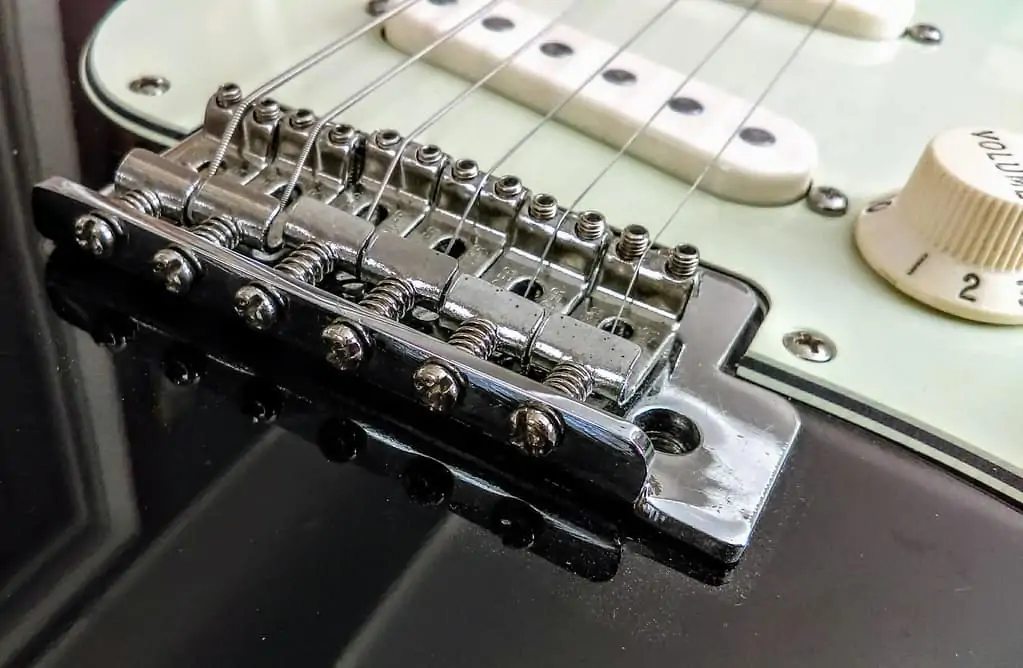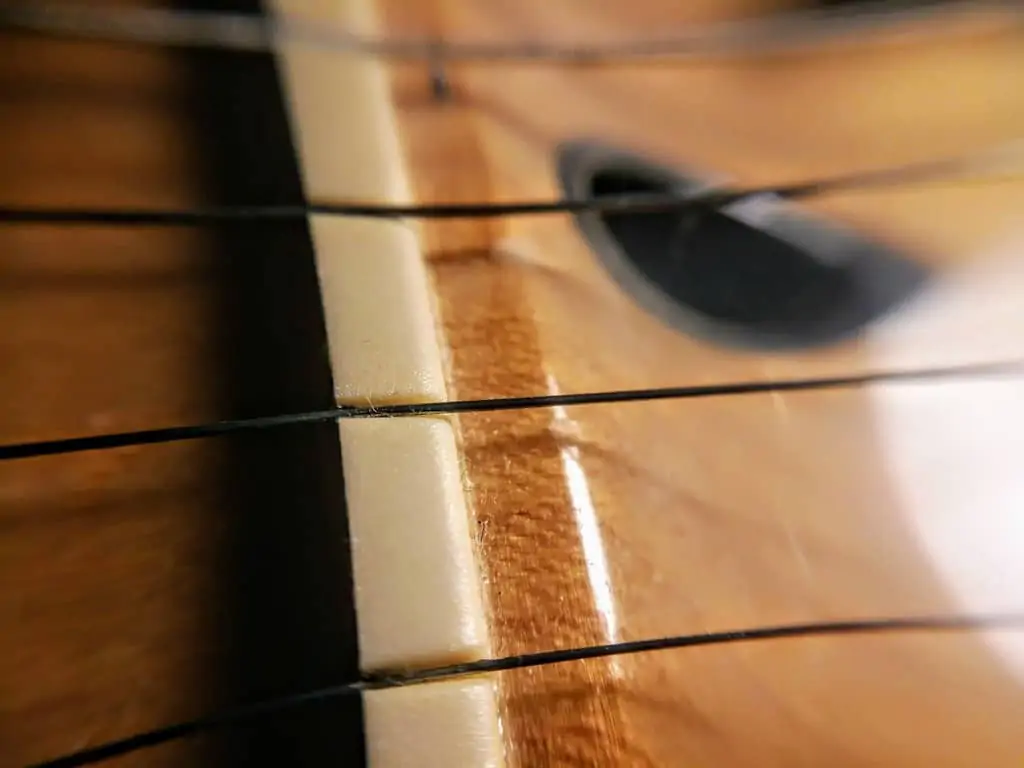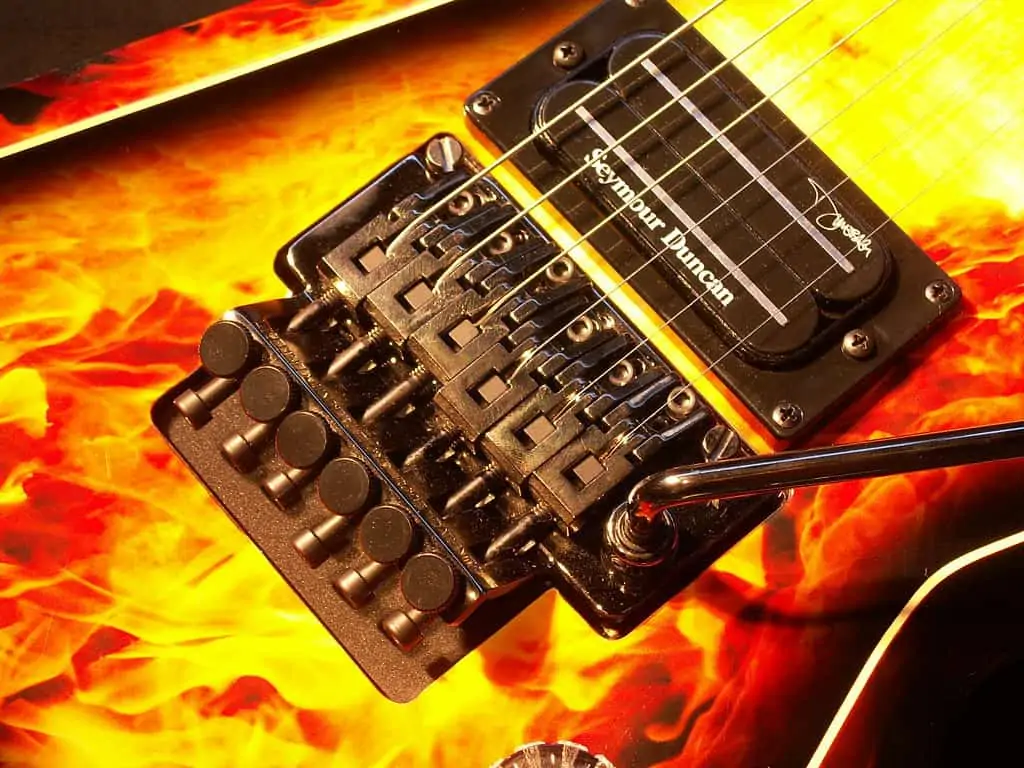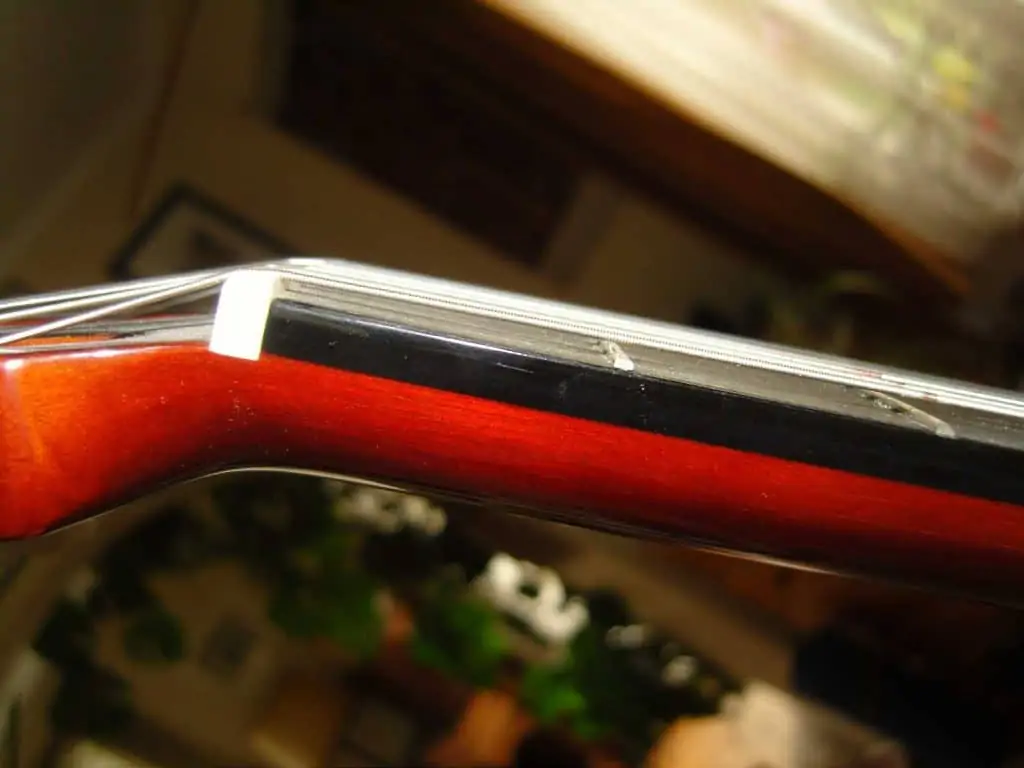Guitar intonation is the way that the instrument is in tune with itself, along the entire neck. Intonation is something that affects basses, guitars and almost any fretted instrument that has a bridge and strings, and can make a massive difference in the way your guitar sounds – making or breaking whether you sound good while playing.
If the intonation on your guitar is out of whack, you’ll find that the guitar sounds awful – no matter how often you tune it. This is because fretted notes will sound sharp or flat as the strings aren’t compensating correctly for any tension, which will mean that the tension when you’re fretting a note is too high or too low – affecting the pitch of the note.
Your chords will sound bad if your guitar intonation is out of line.
How to test your guitar intonation
You can test to check whether your intonation is good or bad very simply. There are a few levels of accuracy you can use here, but all you really have to do is play an open string, and then play that same string at the twelfth fret. This is because both of those notes should be the same, but an octave apart. For instance, an open E string rings out an E note, and fretting that same string at the twelfth fret will also play an E note – just higher up. If you notice that these two notes sound dissonant, or are out of tune, your guitar might have an intonation problem.
To get a bit more specific with it – and this could be useful for when you come to fix your intonation – you can use an electric tuner (or a tuning app). I’d recommend the D’Addario PW-CT-17YL Eclipse Tuner. I’ve got a few of these, and they’re not only easy to see (with a very clear and colourful screen), but they’re also very precise. On top of all that, they’re even more convenient in as much as you can turn the screen to face you from almost any angle – which is really useful if you’re tuning different instruments or working in a bit of a cramped space. This tuner can be used on both electric and acoustic guitar (or an electro-acoustic guitar), bass, ukulele, banjo, mandolin — almost anything with strings! They’re cheap, and come in a range of funky colours too – always nice!
Once you’ve got your tuner, simply attach it to the head of your guitar and play the twelfth fret of any string. Then, once the tuner gives you your pitch (and it’s in tune – always tune your guitar as best you can before testing this), play a natural harmonic on the twelfth fret of the same string. To do this, just gently rest your fingertip on the string, over the twelfth fret, and pluck as normal. It might take some practice, but when you do it right you’ll hear a note produced that sounds a little different to a normal fretted note. See what the tuner tells you this note is — it should be exactly the same as your fretted twelfth fret note, but if it’s not, you’ve got an intonation problem.
If the harmonic is lower in pitch than the fretted note, you’ll need more tension. If the harmonic is higher in pitch than the fretted note, you’re going to want to ease the tension off the string.
So now that you know what you need to do – how do you do it?
Tuning with an electric tuner
Fixing your guitar intonation
Thankfully, fixing your guitar intonation is usually a pretty straightforward task – as long as you have an electric guitar (for an acoustic, it’s a bit trickier – more on that later). You don’t actually have to shell out for an expensive luthier, and you can take care of it at home with the right tools. Of course, if you do want to send your guitar off to the luthier, they’ll be able to perform a full setup and return your guitar good as new – but if you’re simply looking to resolve your guitar intonation issues today, you’re in the right place.
All you’ll need is a small screwdriver, and you’re good to go. Check the bridge of your guitar (where the strings meet the body), to see if there are any small screws underneath the bridge saddles. Most guitar manufacturers put these in place on the bridge to allow for you to fix your guitar intonation, as otherwise you’d have to be sending it off to the luthier a lot and that might reflect poorly on them. Once you’ve located these screws (they should be “under” the bridge, at the bottom, connecting directly into each saddle), you just need to grab a screwdriver that fits and get to work loosening or tightening (to either increase or decrease tension in line with what your guitar needs).
Be gentle and work slowly, as with most things on the guitar – testing periodically to ensure that your guitar is improving rather than going too far in the right direction or turning the screws in the wrong way entirely – that happens to the best of us from time to time! It’s also absolutely worth noting that if you’re increasing the tension of a string, you will need to loosen that string at the tuning peg while you work (a peg winder will help out here). This prevents the string snapping, because as you’re increasing tension (by lowering the bridge saddle, which increases the string length over the neck), you’ll be offering more string up from the headstock. If you’re working the other way, raising the bridge saddle and shortening the string, decreasing the tension, you won’t need to worry about detuning the string – you’ll be offering up more string from the bridge, so you will need to retune your string to be higher afterwards.
If you find yourself coming up short on a screwdriver that fits these bridge saddle screws, don’t worry; it’s not all that common to need such a tiny screwdriver. I recommend picking up a full service guitar kit from amazon, like this one from Ibanez.
With it, you’ll get a bunch of useful tools – not just a screwdriver to help with fixing your guitar intonation, but also ruler and allen keys to help with action and truss rod adjustments. The allen keys come in multiple sizes, as do the screwdrivers – which means you can use this handy tool across multiple instruments. It’s available for pretty cheap and it’s sturdy – it should be an essential for any travelling musician.
Guitar bridge
A Floyd Rose bridge offers a uniquely fiddly, but still achievable challenge when working on your guitar intonation. Due to the way these bridges work, you’re going to need to get in under the strings and adjust a hex nut on each saddle, before you’re able to shift that saddle and get started on fixing your guitar intonation.
If you have an acoustic guitar, I would recommend taking it to a luthier. Adjustments to intonation for an acoustic guitar are a lot more tricky, nuanced and generally if your acoustic guitar is badly intonated there’s a bigger issue going on. This is because of the differences between the bridges of electric guitars and acoustic guitars, and the lack of bridge saddles or any other easily adjustable guitar intonation methods. Typically, when luthiers are working with acoustic guitar intonation, you’ll find that they carry out a full repair, maintenance and setup job on the guitar before actually attempting to fix the intonation. This is because a lot of intonation issues on acoustic guitars can be resolved with some truss rod adjustments, fixing any bowing of the neck and adjusting the action of the strings to be nice and low to the fretboard without buzz.
From there, a guitar luthier or technician will usually focus on the nut of the guitar (the small bone, wood or plastic fret where the fretboard ends and the headstock begins). Nuts have grooves cut into them for the strings to pass through, and if a truss rod adjustment hasn’t resolved your intonation problems, these grooves must be adjusted, cutting them ever so slightly deeper so as to affect string tension across the neck. Again – this is a precise and finicky task, and you’re much better off leaving this particular one to a professional.
“Nut” by zsolt.palatinus is marked with CC PDM 1.0
It is possible to file these grooves down yourself, and it’s even possible to file down the saddle (if your guitar has one) – but it’s precise and if you go too far, there’s no un-filing it to get it back. You can buy saddles or nuts that come already filed and adjusted for intonation but really that’s not a great solution; your guitar intonation is unique to your guitar so anything pre-made might not work.
Now that you’ve got your guitar intonation sorted, and you’ve re-tuned your guitar back to perfection – how do we stop it slipping out of line again?
What affects guitar intonation?
The guitar is a pretty complex instrument, in a lot of ways. There’s a delicate interplay between a lot of different components, even in fairly simple models – let alone more complex seven string guitars, or guitars with fanned frets – or shredding monsters equipped with Floyd Rose bridges!
“Floyd Rose close up” by jonsson is licensed under CC BY 2.0
Obviously – first things first – your strings. Thicker string gauges mean the strings exert more pull on the guitar, and need to be put under more tension to keep them in line. Thinner strings need less tension, otherwise you risk them snapping. If you fit new strings on your guitar, and they’re not the same gauge as the previous set, you’ll need to check your intonation.
If your strings are old, this can also have an effect on your guitar intonation. As you play, the metal frets will grind and rub away at the strings, wearing them down in the places where the string touches the fret and causing the shape and tension of the strings to change. This new shape can affect how the string interacts with the frets, and can mess with your guitar intonation in a pretty subtle but absolutely noticeable way. If your strings are looking grimy, or you know you haven’t changed them in some time, it’s worth a change to a fresh set!
Next up – the action of the guitar. If you carry out an adjustment to your truss rod to correct a bowed or curved neck, it’s going to affect the tension across all of your strings. You’ll need to adjust the saddles and your guitar intonation, because your neck will be slightly longer or shorter than it was before. This is key, and probably one of the bigger elements of your guitar that can affect your guitar intonation – the neck and bridge are the main elements that deal with tension for the strings, so it makes sense that problems or adjustments in these areas affect the intonation of your guitar the most.
The action of your guitar
Anything that affects the action of your guitar and the relief of the neck will also mess with your guitar intonation; this includes just time passing. It’s worth sending your guitar in for a professional once-over and a setup every now and then to ensure that everything is hunky dory, because so many things can affect the action of your guitar – the amount you play it, direct sunlight on the neck, humidity, heat, the way it’s leant (never put the weight of your guitar on the head when you lean it, it’ll cause the neck to bend), all kinds of basic environmental and situational elements can really affect your instrument.
Of course, if you want to avoid having to deal with intonation – you could always grab a carbon fiber guitar!







